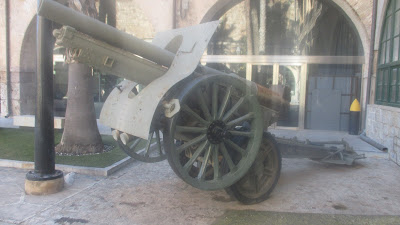Wednesday Walk
As part of our attempts to create a life here in Spain, we joined a walking group based in our local town San Vicente del Raspeig. Now we are the only British people in the group (there are a couple of French too), but most people in the group only speak some English - in fact most speak Valencian rather than Castilian also! But we have over the last 18 months or so made ourselves understood and are now treated as regulars and part of the group.
Today`s walk (29/10/2025) was about 14km down the valley from San Vicente Fire Station winding down past the special forces base at Rabassa (Alférez Rojas Navarrete) to Alicante Cemetery and back.
Rabassa has been a military base since before the civil war and the route took us past a couple of observation bunkers which were positioned to cover the aproaches to both the base and airfield (where the university is today)
First view of bunker 1 silhouetted in front of Alicante
Rear approach and view
View from the roof
Inside, just a simple circular position with roof, but there is cover under the lip to duck down into
Rear entrance
Bunker 2 from bunker 1
Bunker 2 approach
Bunker 1 from bunker 2
Inside similar to bunker 1 except the emplacement is a pipe with one access point and the main body is hollow allowing the occupant to duck into it
rear access
views from the roof
Bunker 1 from below the escarpment
both bunkers from down in the valley (bunker 1 just visible on the far left)
Grave of Miguel Hernández, poet and playwright who died from illness caused by miss treatment in prison by the Nationalists on 28th March 1942. For those of you who visit Alicante you will note the airport has been renamed in his honour.
Memorial
for The Boné
Rebellion was
an uprising that took place in Alicante, from January 28 to
March 9, 1844, against the liberal
government of González
Bravo,
which had been formed at the end of 1843 after the fall
of Espartero's
Regency in
July of that year. The rebellion, led by cavalry colonel
and commander of
the Carabineros
(national police), Pantaleón
Boné,
consisted of a popular uprising of progressive
liberal citizens
who demanded a series of political, economic, and social improvements
in response to the return to power of the moderates.
Grave stone of a child killed during the bombing of the Alicante on 25th May 1938 😭
Memeorial to those killed in Alicante and buried in this mass grave
Memorial stone listing persons known to have been executed by the Nationalists
Memorial on the mass grave
The Army Airmobile Force (Spanish: Fuerzas Aeromóviles del Ejército de Tierra, FAMET), the army aviation branch of the Spanish Army, have been buzzing about all day today.
A couple of Super-Pumas with a Chinhook buzzed us virtually all day, several times single helos of one type or the other flew over and there was even a pair of Tiger attack helos!
I`m guessing there was a major training exercise to do with the Special Operations Command (Mando de Operaciones Especiales) or MOE possibly including the military range which is at the far end of the Agost valley.

















































..jpg)







